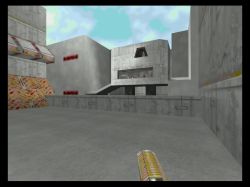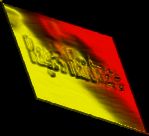PROS:
Good 3D acceleration , excellent image quality , 2D/3D
solution. Low cost (if it will be released !)
CONS:
Not as fast as leading 3D accelerators , such as RIVA.
2D not impressive.
RATING:
8/10
IMAGE QUALITY:

(note ,JPG compression somewhat
degrades image) |
Before I begin the review
, I would like to say that there isn't much of a chance for the Warp 5
to ever be released into the market. Oak has decided to abandon their 3D
graphic and audio departments. See http://www.oaktech.com/pressrel/q298.html.
It is not quite clear what will happen with the Oak Warp 5 chip , however
Jon Peddie Associates (www.jpa.com) have
an interesting suggestion. Anyway , on to the review...
The first thing that struck me when I
opened the card board box containing the Warp 5 was the heat sink attached
to the chipset. (I wish nVidia could have thought of this) It was
nice to know that Oak realized that their chip runs exceptionally hot and
requires this cheap addition. Installing the board was a breeze , as it
should be , insert the card , turn on the computer , win95 does the rest.
(Plug & Pray at its best :)
When it comes to raw speed , the Warp
5 lags a little behind the competition (namely 3Dfx and nVidia). In Turok
demo , the Warp 5 draws 13.1 stunning 800x600 frames in a second , compared
to the 19.6 of the RIVA. Since the Warp 5 only supports Direct3D (another
weakness) , I could not compare Quake frame rates. (If you know where to
find a D3D Wrapper , please e-mail me!)
However , when it comes to image quality , the Warp 5 is king. In my opinion
, the Warp 5's image quality makes even the Voodoo weep! The advanced tri-linear
filtering and excellent anti-alaising remove pixelation and jaggies completely.
The Warp 5 also implements many innovative techniques in order to achieve
its brilliant image quality. The Warp 5 renders the screen tile by tile
, like the PowerVR , eliminating the need for a large Z-buffer and allows
the Warp 5 to use a 24bit Z-Buffer. Also , the Warp 5 stores sub-pixel
values on chip , which explains its awesome anti-alaising. (I believe the
Warp 5 does per-pixel MIP mapping like the 3dfx , but i'm not sure) The
innovative architecture of the Warp 5 is double sided. The FreeZe algorithm
conserves memory and frees up bandwidth , at the expense of being different.
The problem with this Z-buffer approach is that software cannot manipulate
the FreeZe Z-buffer as it can a normal Z-buffer. This may be one of the
reasons which companies did not wish to adopt the Warp 5 , though Metabyte
(www.metabyte.com) did originally
plan on manufacturing the Warp 5 based Wicked 3D.
All in all , the Warp 5 is a good card.
Even though its 2D and 3D speed aren't up to par with the latest accelerators
, the Warp 5 holds its ground with stunning image quality. Unfortunately
, we may never see the benefits of the Warp 5 come into play...
--Rage
Go Back<-
|


